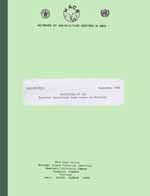
| NACA/WP/82/4 | September 1982 |
 |
Facilities of the Regional Aquaculture Lead Centre in Thailand |
NETWORK OF AQUACULTURE CENTRES IN ASIA
Bangkok, Thailand
September 1982
Hyperlinks to non-FAO Internet sites do not imply any official endorsement of or responsibility for the opinions, ideas, data or products presented at these locations, or guarantee the validity of the information provided. The sole purpose of links to non-FAO sites is to indicate further information available on related topics.
This electronic document has been scanned using optical character recognition (OCR) software. FAO declines all responsibility for any discrepancies that may exist between the present document and its original printed version.
The Regional Aquaculture Lead Centre in Thailand (RLCT) is administered and managed by the National Director, Dr. Thiraphan Bhukaswan appointed by the Thai Department of Fisheries (DOF) in October 1981. He is also concurrently the Director of the National Inland Fisheries Institute (NIFI) of Thailand. His counterpart is the NACA Coordinator, Mr. Chen Foo Yan, an FAO staff member whose regional head office is located at NIFI.
The principal activities of the Centre, as with any Lead Centre of NACA, are in multidisciplinary and system-oriented development. In complementing the effort by the other lead centres on aquaculture technology development for the Asia-Pacific region, the Centre focuses its research on the following culture systems:
Pond culture of air breathing catfish (Clarias batrachus) and snakehead (Channa striatus)
Pond culture of giant freshwater prawn (Macrobrachium rosenbergii)
Pond culture of local carp (Puntius gonionotus)
Cage culture of river catfish (Pangesius sutchi)
Rice field culture of Sepak Siam (Trichogaster pectoralis)
Culture of mussels and oysters
Personnel involved in RLCT activities are mainly staff of the Department of Fisheries working at various fisheries establishments throughout the country. Additional personnel from Universities and other tertiary institutions are encouraged to participate in RLCT activities. At present, besides the NACA Coordinator, and FAO Research Associate, Mr. G. Spiller, recruited in January 1982 under the FAO Associate Expert Scheme, is attached to the Centre.
The Department of Fisheries has some 27 aquaculture field stations and two institutes, NIFI at Bangkok and NICA (National Institute of Coastal Aquaculture) at Songkhla. Twenty field stations (including the Chachoengsao and Suphanburi stations) scattered throughout the country, are involved in freshwater fisheries. Seven stations in coastal southern Thailand work on brackishwater fisheries. The stations have relatively few professional staff (an average of 3.2/station), limited laboratories and a complement of rearing ponds and tanks, much of the work is on fish seed production and distribution but also includes extension services and research on local problems. The institutes are primarily geared for comprehensive research, technology development and training but they also produce fish fingerlings for distribution. NICA has 31 professional staff while NIFI has 40.
Work of the Lead Centre in Thailand can potentially occur at any of the 27 field stations and the two institutions. The facilities of RLCT can thus be any of the facilities of the above designated by DOF at any particular time for deployment on specific RLCT assignments. Some non-government facilities could also be involved with access to them by DOF. An example of the latter case could include private fish farms where observations would be made by groups on a training course or where data are collected for research purposes.
At present, the RLCT research activities have been identified for execution at three locations, NIFI, the Chachoengsao Fisheries Station and the Suphanburi Inland Fisheries Station. Most of RLCT field experiments are conducted at the field stations in Suphanburi and Chachoengsao. The facilities available for development on RLCT work at these locations are described below.
The NIFI complex includes a central building (containing offices, laboratories, a library, lecture rooms and an auditorium) with an aquarium annex, a hatchery and adjoining fish feed processing plant, service building on-site rearing ponds and a satellite rearing station about 1 km away. The Institute operates under the administration of the Division of Freshwater Fisheries, DOF, and is managed by a Director. The core of NIFI is a complement of fisheries scientists grouped into units according to disciplinary functions. Personnel of the Institute presently comprise 40 scientists, about 32 technicians, about 5 office staff and some 120 service staff (maintenance, drivers, attendants, etc.). Some scientists and technicians are also involved in the administration of the Institute, either part-time or full-time.
Apart from four executive offices, the scientific staff of NIFI is accomodated in 10 office-cum-laboratory complexes of about 120 m2 each. These rooms consist of central lab area with all services (water, air, gas, electricity, fume hoods, etc.) and with offices as annexes. A similar room has been allocated to NACA to serve as its regional head office.
Eight laboratories are specially equipped for particular functions, some of which have been strengthened by NACA. They are:
Biology Lab - sorting analysis, preservation and storage of field samples (mainly benthos, plankton and macrophytes); balance rooms and general lab equipment
Chemistry Lab - analysis of water, bottom materials and promimate composition of biota; atomic absorption spectrophotometer in an attached environmentally controlled room
Pollution Lab - equipped for toxicological studies with bioassay diluters, specrotrophotometers, water and enzyme assay apparatus, etc.
Histopathology/Parasitology Lab - fully equipped with microscopes, tissue processor, microtomes and materials involved in histological and parasitological studies
Microbiology Lab - geared and equipped for the study of microbiology and pathogens of fish: microscopes, autoclave, etc.
Nutrition Lab - geared for the preparation and analysis of test lots of fish feed: mixers, blenders, kjedhal digesters, lipid extractors, etc.
Wet Lab - live holding of text lots of fish; recirculation, filter and aeration systems: 9 × 250 ft3 tanks and numerous small glass aquaria
Museum - systematic, taxonomic and distribution studies of fish, amphibians, molluscs, arthropods (shrimps, prawns and crabs) and aquatic macrophytes; specimen storage.
Two rooms in NIFI are used for group teaching and meetings. The major room is the 280 m2, split-level auditorium capable of seating 130 people on the ground floor and another 70 in the balcony. A 100 m2 room in the laboratory wing is set up for small groups of 30 to 40 people maximum.
The NIFI library occupies about 140 m2 in two levels. The ground floor contains the reception area, book stacks and some reading tables. The upper floor is compartmented into reading cubicles.
Library entries mainly relate to freshwater fisheries and comprise more than 2,000 texts, 90 journals in complete and partial series and 4,000 separate and other papers. These have been supplemented by NACA.
The library services have also been strengthened by NACA with the installation of a Hewlett Packard computer (HP3000/30 series) in a specially prepared room adjacent to the library.
Most of the 840 m2 floor space of the hatchery is allocated to rearing tanks - 24 × 6 m3 tanks plus numerous research aquaria - that are serviced by overhead water and air supply lines. Small offices and storage rooms occupy the balance of space.
The fish feed processing plant is located in a 180 m2 annex to the hatchery. It contains small labs, storage rooms and a pellet mill with a capacity of 3 tons/day. The plant produces experimental diet as well as feed for fish reared at NIFI and some Fisheries Stations.
Some 69 rearing ponds, with a total area of 13,000 m2, are located behind the main building of NIFI. Sixty-six ponds are concrete; their combined area is about 3,600 m2. Some water is obtained from stand-pipe storage that is pumped from local wells, and some water is drawn from nearby canals. Air supply lines, servicing about half the ponds, are under re-development. The ponds are used for production of fish fingerlings and some research.
A supplemental rearing facility, with a capacity to raise 5 million fingerlings/yr, is located about 1 km west from the NIFI head office. It contains 40 concrete ponds ranging in size from 5 m2 to 50 m2 and 22 earthern ponds in the size range 100 m2 to 1,600 m2. Water is obtained from adjoining canals. Other facilities of the 2.8 ha site include storage sheds, houses for staff and a small hatchery.
The tri-level aquarium complex annexed to the main NIFI building has a total floor space of 1,300 m2. Display tanks are located on the first two floors while reserve stock and experimental fish are held in tanks on the upper floor. The aquarium is equipped with its own water recirculation, filtration and aeration systems.
The Chachoengsao Fisheries Station, alternatively called the Central Giant Freshwater Prawn Research and Training Centre, operates administratively under the Deputy Director General of Fisheries. The station, located on a 11.5 ha site about 100 km east from Bangkok in Bangpakong District of Chachoengsao Province, includes an office, staff housing, a small lab, some 168 rearing ponds, and tanks and two relatively large water storage ponds. The staff complement includes 6 scientists, 2 technicians and about 35 attendants and maintenance personnel.
The lab is equipped to perform basic analyses of water and examinations of biological samples. Apparatus such as aquaria and life support services are also available for experimental work on live animals.
Of the 168 rearing ponds and tanks, 12 are large earthen ponds, 54 are small earthen ponds and 102 are concrete tanks. The latter includes 15 ton hatching tanks and 50 m3 nursery tanks.
One large earthen pond is used to store freshwater while the other stores sea water.
The Suphanburi Inland Fisheries Station operates under the administration of the Division of Freshwater Fisheries. It was built in 1978 on a 4.6 ha site 190 km northwest of Bangkok in Suphanburi Province. The station consists of an office building, a hatchery complex of 10 concrete ponds and 72 tanks, and a field facility of 25 rearing ponds. There are 6 houses providing living quarters for most of the staff of 34, including the Station Head, 4 biologists, 4 extension officers and about 25 attendants and maintenance personnel.
The hatchery complex consists of ten 50 m2 concrete ponds. Of the 72 tanks, 30 are 10 m2 in size while the rest are 3 m2.
The number and size of the 25 rearing ponds are: 15 (800 m2), 5 (1600 m2), 4 (4800 m2) and 1 (3200 m2). Water supply to these ponds is pumped from a swamp adjacent to the station.
